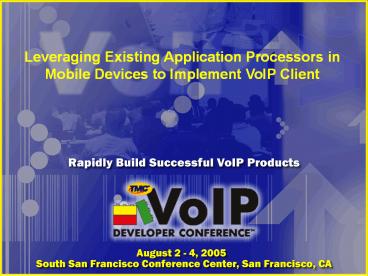Leveraging Existing - PowerPoint PPT Presentation
Title: Leveraging Existing
1
Leveraging Existing Application Processors in
Mobile Devices to Implement VoIP Client
2
VoIP Client Requirements Enabling Rich Telephony
Features on Cellular Handset
- Standards Compliant and Interoperable with VoIP
networks - Based on IETF RFC SIP 3261
- Support for standard audio compression formats
used in VoIP networks - G.711, G.729A/B, G.723.1, G.726, GSM-AMR, G.722,
G.722.1, G.722.2 (AMR-WB) - Implement basic and advanced signaling and call
control features - Call Setup, Teardown, Hold/Resume, Transfer,
Multi-Line appearance - Local 3-Way conferencing (requires 2-channels),
bridged-conferencing - Mid-Call DTMF, CPT, Polyphonic ring tones
- Text Messaging and Presence (SIMPLE)
- Authentication and Security mechanisms
- Proxy Discovery
- Support Hands-Free speakerphone operation
(Acoustic Echo Cancellation) - QoS Noise Cancellation, Adaptive Jitter Buffer
and Lost packet Concealment - Configurable by provider and user in field
3
VoIP Client RequirementsDesign Considerations
- Co-Exist with current applications and OS
- Minimize Memory requirements for program and Data
- Minimize Processing requirements
- Minimize Power dissipation
- Use the existing User Interfaces (MMI) on the
cellular device - Field Upgradeable
- Deliver Better Voice Quality and an overall
better Communication Experience to the Consumer - And achieve ALL of the above without adding
additional cost to the BOM
4
VoIP Client Traditional ApproachHigh Cost, High
Power, Complex Multi-Processor System
- Application processor Non-Compute Intensive
Software Modules - OS
- Network Stacks
- VoIP Protocols, System Framework, System
Software, Jitter Buffer, Conference Mixer,
Application, Management SW et.. - UI/GUI/MMI
- Productivity Applications
- Drivers
- DSP Processor Compute Intensive Signal
Processing Algorithms - Voice Coders, Echo Cancellers (AEC for Speaker
Phone), Tone Generators, Lost packet
Compensation, Noise Canceller, Media Controller,
Audio capture-playback. - Complex multi-processor system
- Requires DSP processor which adds power and cost
- Software is more complex and DSP sub-system is a
black-box, difficult to upgrade - Locked to proprietary DSP architecture (System is
not Scalable) - Requires Separate Tool chains and Software
development skill set
5
VoIP Client SoftDSP ApproachSingle Processor
Solution
- Application processor All Software Modules
including Media Algorithms - OS, Network Stacks, Drivers
- VoIP Protocols, System Framework, System
Software, Jitter Buffer, Conference Mixer,
Application, Management SW etc. - Voice Coders, Echo Cancellers (AEC for Speaker
Phone), Tone Generators, Lost packet
Compensation, Noise Canceller, Media Controller,
Audio capture-playback.. - UI/GUI/MMI
- Productivity Applications
- Simple and Flexible Design
- Signal Processing Algorithms on general purpose
RISC processor - Scalable for applications like Video over IP
- An Elegant, Simple, low Cost, low Power solution
for VoIP clients on Cellular Handsets - Software requires only industry standard general
purpose RISC Processor Architecture. - Simply upgrading the Processor will achieve
better system performance and the SW will be
reusable without changes - Unified Tool chains and Software development
skill set - Extremely short time to market
6
Media Processing SubsystemRequires 90 of
Processing Bandwidth (MHz / Channel)
AEC 128 ms
SpeechEncoder
PCMI/F
VAD
PCM
PacketI/F
CNGEncoder
Tx
SpeechDecoder PLC
Speech/Lost Pkt
Adaptive Jitter Buffer
SID/DTX
CNG
DTMF Generator
Rx
Tones
7
Software Partitioning Option1
- Implements complete 2-channel solutions including
3-way conferencing on AP - Simple Software Integration on Existing Platform
- Short time to Market of 4 to 10 weeks
- Includes 3-Way conferencing, implemented on AP
- Requires less than 40 MHz/Channel (G.729A/B
vocoder) on ARMv5TE
- Application Processor (RISC)
- Call Signaling
- Call Control Manager, System and Media Frameworks
- RTP/RTCP, SDP
- Application layer and UI
- Call Conferencing Engine
- Media Processing for Channels - 1 2
- Acoustic Echo Cancellation
- DTMF generation
- CPT and Custom Tones
- QOS Adaptive Jitter Buffer and PLC
- Automatic Gain Control
- Noise Reduction
- PCM Handler
Software Added for VoIP
8
Software Partitioning Option1
Channel-1 Media Processing modules (AMR, AEC,
Noise Reduction) targeted on the Application
Processor (ARM RISC CPU)
VoIP Signaling, Packetization Protocols Call
Manager, VoIP media and system Frameworks,
TCP/IP, UDP NW stack
3-Way Conferencing Mixer, Media Processing for
Channel-2 (AMR) targeted on the Application
Processor (ARM RISC CPU)
9
Software Partitioning Option II
- Software Distributed between Host RISC Processor
and DSP processor - Media Processing for Channel- targeted on DSP
Processor
- Existing RISC Microprocessor
- Call Signaling
- Call Control Manager, System and Media Frameworks
- RTP/RTCP, SDP
- Application layer and UI
- Encryption
- Call Conferencing Engine
- Media Processing for Channel-2
- DTMF generation
- CPT and Custom Tones
- QOS Adaptive Jitter Buffer and PLC
- Existing DSP core
- Media Processing for Channel-1
- Acoustic Echo Cancellation
- Automatic Gain Control
- Noise Reduction
- PCM Handler
Platform Services
Existing Software available on Platform
Software Added for VoP
10
Software Partitioning Option II
Channel-1 Media Processing modules (AMR, AEC,
Noise Reduction). Existing algorithms on Cellular
platform
VoIP Signaling, Packetization Protocols Call
Manager, VoIP media and system Frameworks,
TCP/IP, UDP NW stack
3-Way Conferencing Mixer, Media Processing for
Channel-2 (AMR) targeted on the Application
Processor (ARM RISC CPU)
11
Press Release HelloSoft Demonstrates Complete
VoIP Solution on TI OMAP 1710 Cellular Platform
12
(No Transcript)
13
Hellosofts VoIP SolutionAvailable for ARM
MIPS Processors
- Complete Software Solution includes all necessary
Protocols, Algorithms, Frameworks and System
Software for a client device - Highly Optimized VoIP Solution, designed for
single RISC Processor-based designs, Eliminates
the need of DSP (SoftDSP) - Industry-best Performance for Media Processing
Algorithms on RISC processors. - Excellent Voice Quality (PESQ and PSQM Scores)
comparable or better than DSP-based Solutions. - Designed for Portability to Different OS/RTOS and
Processor Architectures (Implements OS
Abstraction). - Modular System Architecture.
- Shipping to major Semiconductor and ODM customers
14
VoIP Solution for HandsetsSoftware Blocks
Licensed by Hellosoft
15
THANKS































